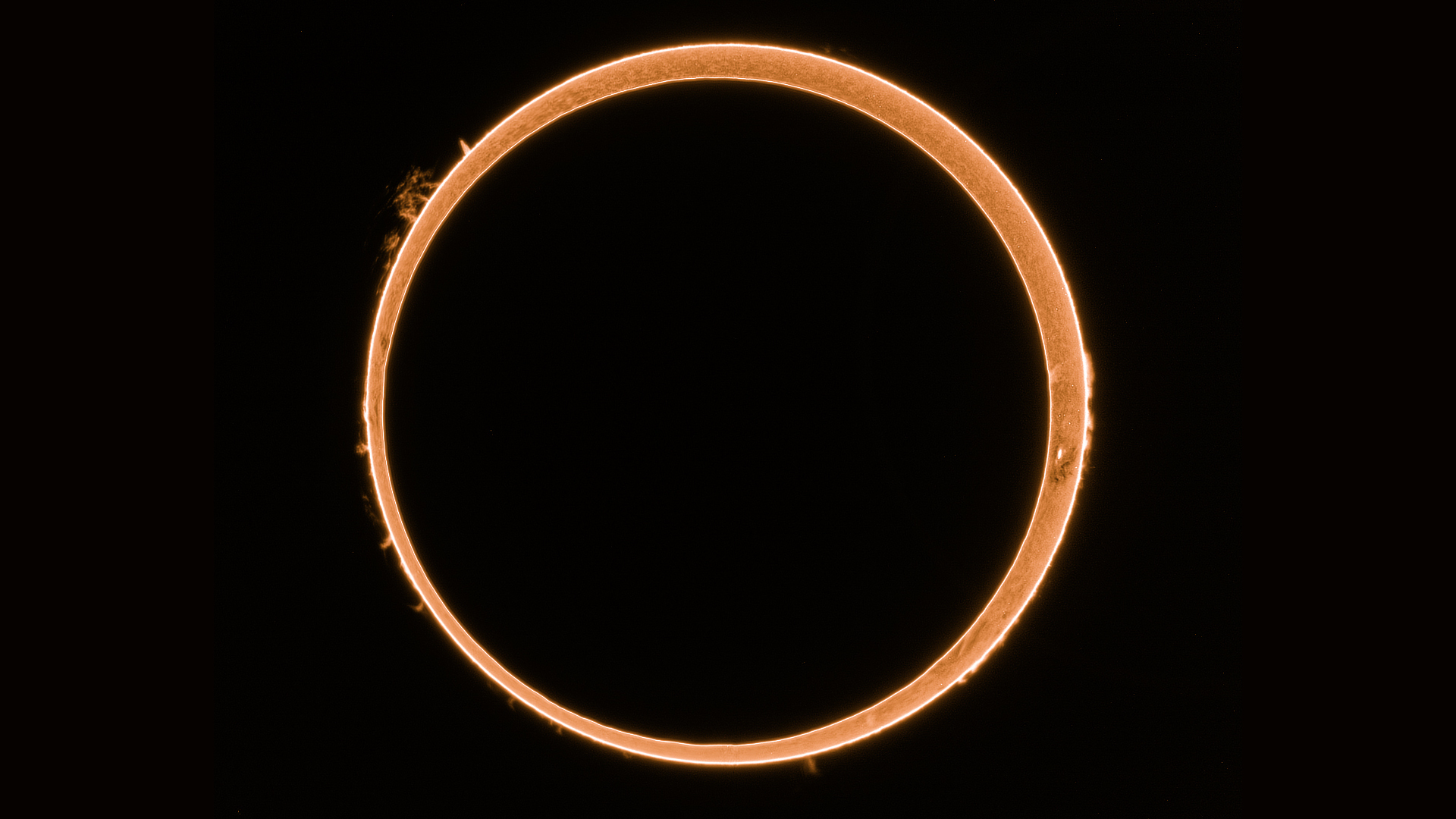Space photo of the week: Easter Island's last 'ring of fire' eclipse for 320 years
Oct. 2's annular solar eclipse saw a small-looking new moon cross the face of the sun to create a perfect circle for about six minutes.

What it is: An annular solar eclipse
Where it is: Over Rapa Nui, also known as Easter Island, in the Pacific Ocean
When it was shared: Oct. 2, 2024
Why it's so special: For up to 7 minutes, 25 seconds on Wednesday, Oct. 2, the new moon appeared to sit perfectly inside the sun's disk during a partial "ring of fire" solar eclipse. On both sides of that short time, the edge of the moon appeared to touch the inside edge of the sun, causing "Baily's beads" — sunlight pouring through the moon's mountains — to fizz. Onlookers had to use solar eclipse glasses and equipment fitted with solar filters to safely observe the phenomenon.
Annular solar eclipses differ from total solar eclipses because the moon is farther from Earth, so the moon can't cover the sun's entire disk. On Oct. 2, the moon eclipsed 86.9% of the sun at its peak while appearing 6.4% smaller than average, according to Moonblink.
However, there are ways to image the eclipse safely while extracting more detail than is possible through regular solar filters. This very special image was taken by astrophotographer Aditya Madhavan while traveling with the eclipse tour group Astro Trails to Easter Island. Madhavan used a Lunt H-alpha telescope, which sees in only the wavelength of light created by hydrogen atoms on the sun.
"We're looking at the sun's image in hydrogen-alpha, and what we're seeing is the chromosphere of the sun, specifically in the wavelength of 656.28 nanometers," Madhavan told Live Science. The sun's chromosphere is a thin layer of plasma that lies between the sun's visible surface, called the photosphere, and the sun's upper atmosphere, or corona, which becomes visible to the naked eye during a total solar eclipse.
Sign up for the Live Science daily newsletter now
Get the world’s most fascinating discoveries delivered straight to your inbox.
"It's a special kind of filter known as an h-alpha etalon that isolates that layer of the sun's atmosphere," Madhavan added. The photographer used a Lunt 40-millimeter hydrogen Alpha telescope using a QHY174 monochrome camera and tracking on a Rainbow Astro RST 135 mount. That allowed him to capture solar prominences — bright features extending outward from the sun's surface and into the corona — around the solar limb
Related: 'Ring of fire' solar eclipse blazes over Easter Island in incredible new image
In sharp contrast to the total solar eclipse in North America on April 8, which crossed over about 50 million people, this eclipse was visible only from within a remote path about 165 to 206 miles (265 to 331 kilometers) wide across remote Patagonia in both Chile and Argentina, where barely 175,000 people live, as well as from Easter Island.
Madhavan observed the eclipse above a spectacular water-filled volcanic caldera called Rano Kau. From that location, annularity — the moment when the moon appeared to sit within the sun with a "ring of fire" circling its edge — lasted up to 6 minutes, 10 seconds.
Although the "ring of fire" was also visible from parts of Patagonia in Chile and Argentina, most eclipse chasers traveled to Easter Island, some 2,200 miles (3,500 km) off the coast of Chile. It's home to roughly 1,000 human-faced moai statues, all staring inland from its coast and constructed mainly between 1150 and 1290. A tiny island covering just 63 square miles (163 square kilometers), Rapa Nui is not often in the path of solar eclipses. This was Rapa Nui's first annular solar eclipse since 1788 and its last until 2345.
It was Earth's first annular solar eclipse since Oct. 14, 2023, the last until Feb. 17, 2026, and the longest until Feb. 6, 2027, when a "ring of fire" will be visible for 7 minutes, 51 seconds from Chile, Argentina, Uruguay, Côte d'Ivoire, Ghana, Togo, Benin and Nigeria, according to Timeanddate.
For more sublime space images, check out our Space Photo of the Week archives.

Jamie Carter is a freelance journalist and regular Live Science contributor based in Cardiff, U.K. He is the author of A Stargazing Program For Beginners and lectures on astronomy and the natural world. Jamie regularly writes for Space.com, TechRadar.com, Forbes Science, BBC Wildlife magazine and Scientific American, and many others. He edits WhenIsTheNextEclipse.com.










